This is a Nikon One Touch AF3 auto focus 35mm point and shoot camera made by Nikon starting in 1987. The AF3 was the third version of the original L35 from 1983 which was Nikon’s first compact auto focus camera. The AF3 has a simpler 4 element lens compared to the original model, but it did have a closer minimum focus which allowed for pseudo-macro closeups. The camera was very popular and well built. The camera was fully automatic and offered no manual control, but it maintained Nikon’s excellent reputation and consistently received rave reviews about the quality of the images it made. As a result, this is one of the few point and shoot auto focus cameras that is desirable by those shooting film.
Film Type: 135 (35mm)
Lens: Nikon 35mm f/2.8 Coated 4-elements
Focus: Auto Focus 1.5 ft to Infinity
Shutter: Electronic Leaf
Speeds: 1/11 – 1/500 seconds, stepless (1/11 is not a typo, its straight from the manual)
Exposure Meter: Dual Silicon Photo Diode (one for AE, the other for auto backlight compensation)
Battery: Lithium 223 6v battery pack
Flash: Built-in “Smart” Flash with manual flash override
Manual: http://cdn-10.nikon-cdn.com/pdf/manuals/archive/Nikon%20One%20touch-SMARTFLASH.pdf
History
Nikon has never been a company that is in a hurry to rush new products to the market. They were one of the last Japanese camera makers to release an SLR when the original Nikon F debuted in 1959, they didn’t build anything for the non-professional until the first Nikkormat in 1965, they didn’t embrace lightweight and compact bodies until the FM in 1977, and they didn’t release anything for the entry level market until the EM in 1979.
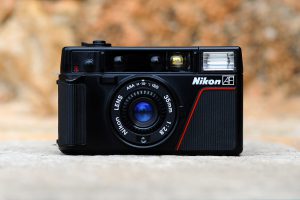
So, it probably didn’t surprise anyone that Nikon took their sweet time to release their first fully automatic compact camera with autofocus when the original Nikon L35AF debuted in 1983. But when they did, they didn’t screw around. That first camera had a 5-element 35mm f/2.8 Sonnar-Type lens that offered sharpness unrivaled in the compact segment at the time. The lens did not feature the Nikkor label typically associated with Nikon SLR lenses, which caused some confusion for Nikon as rumors spread that the lens was built by a third party. This was only a rumor though, as the 5-element lens was both designed and built in house. The designer of the lens was Nikon’s own Mr. Koichi Wakamiya who had designed other Nikon lenses such as the Series-E 100mm f/2.8 and UV Nikkor 105mm f/4.5S.
The L35AF featured an advanced active auto focus system that was said to be more accurate than competing passive systems used by other companies like Konica and Canon, and it featured several other useful features like a focus confirmation LED in the viewfinder, a flash ready LED, +2EV backlight compensation, 46mm threaded filter ring, a self timer, popup flash with daylight fill capability, and fully automatic film advance and rewind.
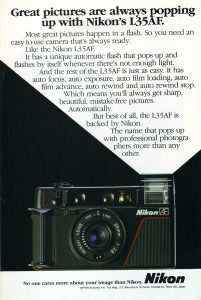
Nikon spent nearly 6 years designing this camera, and the amount of technology and quality that was put into it caused it to earn the nickname “Pikaichi” which is Japanese for “top notch”. When it was released, it received rave reviews in the press all across the world. Its original MSRP was $210, which when adjusted for inflation is a little over $500 today, certainly not cheap, but well within the range of competing cameras of the day.
Although the original L35AF was a huge success, the market for cheap point and shoot cameras was exploding and Nikon was pressured to update the model to stay competitive in the market, so in 1985, the L35AF2 was released. In the United States, this camera was marketed as the Nikon One Touch. It featured a few upgrades, but lost a few things as well.
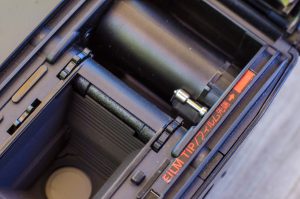
In terms of the upgrades, it now supported DX encoding, which meant that the film speed did not have to be manually set. The range of film speeds increased to as high as ISO 1600 compared to 400 or 1000 in the original model. Loading film was easier as you no longer had to thread the leader into the takeup spool. Simply load the cassette and pull the leader to a line indicated in the film compartment, close the door, and the camera does the rest. The body had a slightly larger hand grip on the photographer’s right side and the body was covered with a grippier rubberized material making it easier to use one handed. Finally, there was an integrated lens cap that would protect the lens when the camera was not in use.
On the down side though, the 5-element lens was dropped in favor of a simpler, and less expensive 4-element lens. While this lens was still very sharp, it was seen as an inferior lens by the public. The camera also lost the 46mm filter thread around the lens barrel and the +2EV backlight compensation switch. It’s possible that Nikon assumed these features weren’t needed by the typical point and shoot consumer.
Once again, two years later, Nikon would release a third L-series camera simply known as the Nikon One Touch AF3. This camera combined many of the best features from the first and second L35AFs and added a few more things to the mix.
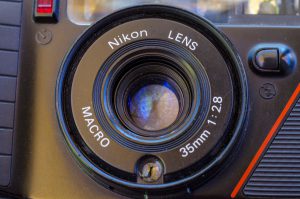
For starters, the 4-element lens from the second model remained, but it was redesigned to add macro focus capability. Minimum focus was lowered to 1.5 feet from 2.8 feet in the older models. To accommodate the closer focus distance, Nikon upgraded the flash, calling it the Smart Flash which would automatically diffuse the light when the camera detected focus closer than 3 feet. Somewhat compensating for the lack of the +2EV backlight switch from the first model, the camera can now auto detect when backlight fill is needed, and will automatically fire the flash if the center of the image is darker than the light behind it. The flash was also no longer a pop-up design, and stayed fixed on the camera body at all times. For the first time in the L-series, a flash cancel button was added to the front of the camera so the photographer could intentionally disable the flash for low light shots. Finally, the flash also had an improved 3 second recycle time which was a huge upgrade from the slower flashes of earlier models.
The 46mm filter ring returned to the front of the lens body, while still retaining the automatic lens cap design of the second model. In my research for this model, I didn’t find mention of any other 35mm compacts being sold in 1987 that had a filter ring making it appealing for people who like to use polarizers, neutral density filters, or any other kind of colored filters.
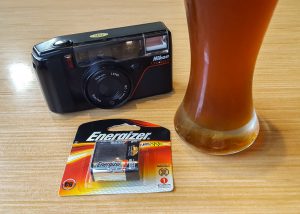
The AF3 also switched from needing AA alkaline batteries to the more expensive 223 6v lithium battery. While the cost of the new battery was greater, it came with the payoff of up to a 5 year lifespan. Nikon rated this battery as being good for 50 rolls of film with 30% flash usage. If you shot the camera without needing the flash, you could get even more life out of it.
As best as I can tell, the One Touch AF3 was a very popular camera among photographers who wanted the simplicity of programmed auto exposure and auto focus, but still retained some level of advanced features. I wasn’t able to tell how long the camera was in production as Nikon released several lower end models around this time and eventually switched away from prime lens compacts to dual length or zoom models.

Today, the Nikon One Touch AF3 is one of the rare examples of a desirable point and shoot compact from the 1980s. Reading other reviews of this camera online, it consistently earns high praise for image quality and ease of use. Despite it’s stance as an entry level model compared to its professional and advanced amateur SLRs, Nikon didn’t skimp on the quality here. One of the best features of the entire L-series is that they often show up for sale at garage sales or Goodwill shops for ridiculously low prices. Many people group these cameras in with the massive amount of low-end plastic cameras from the 80s and 90s, not realizing how good they are. It is not unusual for people to find these for sale for 99 cents or even free, making these cameras one of the best bargains of any camera ever made.
My Thoughts
The Nikon AF3 is now the third all plastic point and shoot autofocus camera from the late 70s/early 80s in my collection and the second that was gifted to me. I never thought I would have an interest in these cameras and I’m still on the fence as to whether I officially can call it “interest”. I’d say, a more accurate word is “curiosity”.
The appeal for me with classic cameras is in the process of using them. I enjoy the requirement to manually focus a lens and to manually calculate exposure and pick appropriate shutter or aperture settings. The more quirky the camera, or the more effort require to capture images, the more interesting it becomes to me.
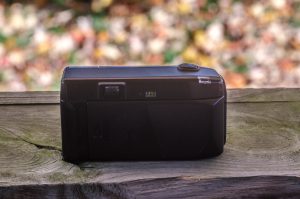
When you use a fully automatic point and shoot camera, absolutely everything is done for you. There’s nothing interesting or unique about the process. Its no different than using a modern digital point and shoot camera, with the exception being you cannot preview your shots after taking them, and you’re still limited to the number of exposures in the film.
Yet, I still have a level of curiosity in how such a cheap and basic camera can perform. How bad could it really be? I feel like these automatic cameras from the late 70s and early 80s were pioneering designs in themselves as they introduced the world to features and capabilities never before possible. In an way, these cameras brought photography to the masses in the same way the original Kodak and Brownies did in 1888 and 1900.
This particular camera came to me from my friend Adam who found it at a Goodwill store for $5. Knowing that I am a pretty big Nikon fan boy and that I would likely appreciate the camera more than he would, he packaged it up in a box with some other goodies and sent it to me. When it arrived it still had the Goodwill price tag on the rear door. The camera looked to be in good condition, and these cameras don’t require any foam light seals to be replaced, so I thought I might as well take it out and shoot some film.
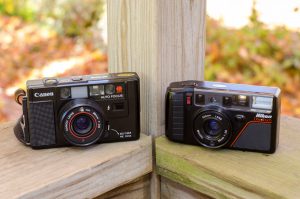
Not so fast. As it turns out, this free camera required a $10 lithium battery. Thats ok though because these batteries last forever, and it’s highly likely I’ll come across another camera that can use it, so I went to my local hardware store, picked up a battery, loaded in some film and went shooting.
I mentioned earlier that this was the third fully automatic point and shoot camera I owned. One of those other two cameras, the Canon AF35M from 1979 was one of it’s direct competitors. To be completely fair though, the AF35M pictured to the left is 8 years older than the Nikon. A more fair comparison would be between either a later variant of the Canon and the original Nikon L35AF from 1983. Since I don’t have those two exact models to compare, I’ll just say that despite their age gap, the two cameras still share a lot in common.
For one, the feature set is nearly identical. They both have excellent 4-element f/2.8 lenses with nearly identical focal lengths and 46mm threaded filter rings, an active auto focus system, an in-body flash and a bright, but very spartan viewfinder.
The Nikon being a newer model has macro focus, a more advanced flash with faster recycling time, is quieter, and has a simpler process for loading and rewinding film. The Canon uses cheaper and easier to find AA batteries compared to the $10 monster in the Nikon, but had I been doing an apples to apples comparison, the earlier Nikon L35s used these same batteries as well.
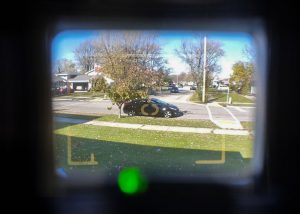
Ignoring the differences that the 8 year newer Nikon has, these cameras are still very comparable. Auto focus is only possible in the center of the frame. The focus area is indicated by a pill-shaped circle in the center of the viewfinder. If you want to focus on something that’s not in the center, you can half press and hold the shutter release with what you want to focus on in the center of the image, but then recompose the image while still half pressing the shutter release and the camera will remember the original focus location when you press the shutter release the rest of the way. The AF3 has a green focus confirmation LED that will illuminate in the viewfinder to confirm that the camera has what it thinks is correct focus. You just have to trust it as there is no type of rangefinder or through the lens confirmation. The camera is designed to flash the green light if focus cannot be obtained either due to being too close to the subject or a scene that’s too dark.
The viewfinder also has a red LED that will illuminate if the camera determines the flash is necessary. The flash recycling time on the AF3 is much faster than the Canon’s at 8 seconds, but once again, I would expect the Nikon to have benefited from 8 years worth of advancements. Still, a 3 second recycling time is slower than you’d likely expect from a modern digital camera, so if you attempt to shoot a photo before the flash has been fully charged, the camera will flash the red LED in the viewfinder and lock the shutter until it’s ready.
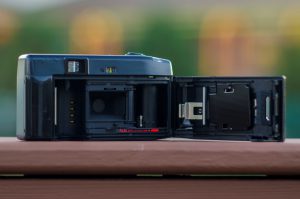
Both models have a self timer, the ability to pre-focus on an object not in the center of the viewfinder, and a flash override, all three of which are more eloquently executed on the Nikon.
One last thing that both have in common are how loud they are. The Nikon’s isn’t quite as bad as the Canon, but it’s worth mentioning that neither of these cameras would be recommended for discreet photography. Since most of the noise coming from the AF3 is in the film advance, you can minimize the noise somewhat by holding the shutter release down after taking a photograph as that will prevent the film from advancing until you release it. Take your image, keep the button pressed, and then move the camera into a quieter location before releasing the button and allowing the loud film advance to commence. Still, it’s much louder than modern cameras. I have to imagine quite a few 1980s parents must have drawn the ire of a quiet audience at a child’s dance rehearsal upon subjecting them to the cacophony of screeches and mechanical groans from either of these two cameras. I guess it was a sign of the times, however.
Holding the camera, it is definitely light weight, but lacks that cheapness of later plastic point and shoot cameras. The body feels well put together and does not creak in your hands while holding it. The AF3 might be made entirely of plastic, but Nikon didn’t cheap out on build quality. The camera weighs a scant 280 grams without any film or battery, and 318 grams with the battery, but still no film. It’s certainly light weight, but still gives the impression that it was well made.
For all of the advancements these models boasted, it wouldn’t be for much if the images weren’t any good. While we generally think today that your basic point and shoot camera should be cheaply built with a low expectation for quality optics and sharp images, these cameras pre-dated that “disposable” mentality that has become so prevalent over the past couple of decades. Both of these cameras had lenses that their respective manufacturers were proud of, and it’s this reputation that has allowed these models to enjoy some level of desirability among collectors nearly 3 decades later.
My Results
I am a bit of a control freak when it comes to shooting film, but having a little bit of experience with 1980s auto focus plastic cameras, I felt more prepared to just trust that the camera would handle everything with little to no input from me.
In an effort to add some level of uniqueness to a camera that likely would function identically to the Canon AF35M and AF35MLs already in my collection, I decided to go outside of my color-comfort zone and load in a fresh roll of Ilford XP2 black and white film. I don’t often shoot with black and white because I don’t feel that I have an eye for it. I’ve seen some really wonderful black and white images shot by good photographers, but whenever I do it, they always seem to be missing something.
These images reflect 8 of that roll of 24, and I am happy to report that every single image was correctly in focus. Nikon had clearly worked out any auto focus kinks by 1987 when this camera first went on sale.
Notice the second image above of the stick with the fungus growing out of it. I centered the viewfinder exactly where I wanted the image focused and the camera nailed it perfectly. The fourth image of the narrow gravestone with the Freemason logo on it was another good test as the camera would have only had a very narrow area in which to focus on. If it did it incorrectly, the gravestone would be out of focus and possibly the trees behind it, but no, the Nikon got that too.
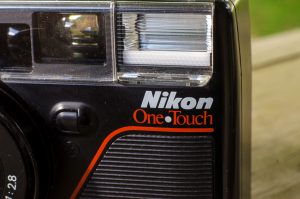
The reputation of the lens shines through here as the images are all very crisp and sharp. I’ve never shot with the original L35 with the 5-element lens, but I can’t image it would have been much better.
If there was one complaint I saw with these images, is that some of them seem to have harsh contrast. I think that’s more of an issue with the film, than the camera however.
Overall, I am very pleased with these images and feel that if my experience with this camera is consistent with the others out there, the AF3’s positive reputation is well deserved. Had I been in the market in 1987 for an easy to use point and shoot for family snapshots, I think this camera would have been at or near the top of my want list.
For those of you still interested in shooting film, is there enough about this camera to warrant a look? I think so. This is a perfect camera to keep in the glove box of your car, or a backpack for those spontaneous shots where you dont want to lug around an SLR or some other large camera. With it’s small size and ease of use, its reassuring to know you aren’t compromising on the images it will make.
My Final WordHow these ratings work |
The Nikon One Touch AF3 is a well regarded example of 1980s auto focus simplicity. In my test, I found it deserving of it’s reputation. The auto focus system works perfectly, the lens is capable of sharp and properly exposed shots, and it can close focus down to 1.5 feet. The camera is designed to nearly everything for you. It supports DX film encoding, and other than flash override and a self timer, there is absolutely no other manual control over your shots. But that’s OK, because it did a great job at everything I threw at it, and I found no compromise in exposure, focus accuracy, or image sharpness. When it was new, this camera sold for the equivalent of over $500 today, yet these days, AF3s often sell for a couple of bucks at garage sales and thrift stores, making the Nikon AF3 one heck of a value. | ||||||
| Images | Handling | Features | Viewfinder | Feel & Beauty | History | Age | |
| 2 | 2 | 0 | 1 | 1 | 1 | 0% | |
| Bonus | +1 for its perfect execution of focus, exposure, and image quality | ||||||
| Final Score | 8.0 | ||||||
Additional Resources
http://www.35mmc.com/28/03/2015/nikon-af3/
http://camerapedia.wikia.com/wiki/Nikon_AF3/AD3/One%E2%80%A2Touch


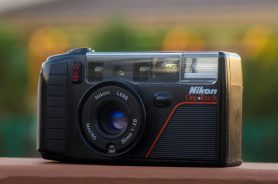
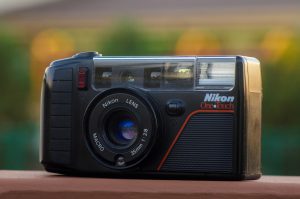








Hello,
Thanks for your article, good read.
I just found one which looked to be fine. The body has no wear and looks top-notch. But when I insert a battery and turn the camera on, the camera keeps making a winding sound, even if I open the camera. This is my 5th Nikon L35 but i never seen this problem.
Do you know what i could do to maybe fix this??
regards
My grandpa had one of these in the late 80s. He was thrilled with it, and I didn’t understand why he didn’t just carry his OM1N or Rollei B35. Reading this review and keeping in mind that we weren’t used to digital convenience, I see why. No one had to wait for him to set the camera, (something he was slow at) so he could take pix on the fly. Great lens. I wonder if it was a Zeiss Tessar copy? (since the original was a Sonnar copy)
Some people tend to forget that just because a camera is simple to use, doesn’t mean it’s not capable of excellent results. There are many other point and shoot cameras like this Nikon that deliver just as great of results. That’s not to suggest that anyone should immediately throw away all their SLRs and rangefinders, but to universally dismiss all point and shoots limits your photographic opportunities!
Muy detallada la información, quisiera saber si lo que vemos visor es la imagen que saldrá en la película, o tiene error de paralaje.
Got one of these from shopgoodwill-dot-com — to test out to see if it would be good for my 2-yr-old grandson (very precocious and rambunctious, and I think that he can handle a point-and-shoot). Looks in fine shape — shot the first 10 shots of a roll of Kodak ColorPlus 200 just now — will try to finish this weekend. Autoflash and focus indication (blinking green LED if too close) seemed correct. My daughter (grandson’s mom) is a semi-pro with a Nikon DSLR, and of course my grandson wants to take pictures with Mommy’s camera also! So I thought that a black point-and-shoot with “Nikon” on it would satisfy him that he has a camera like Mommy’s, and even with no film it makes noises like it is taking a picture, and the flash goes off if dark enough — but I did want to see if such a camera actually could take photos as well. When I send it to him, I will include a batch of batteries, and also a handful of rolls of film — so that Mommy can load it with film and let my grandson “be a photographer” and we can actually see what he produces! Should be fun. Thank you for the review and info as always!!!
I absolutely love this post, I bought an L35AF new ca 1982 (?), it was stolen from my car in 1990. I since got two L35AF, one waiting to be tweaked, the other to be fixed, and I just bought a third to see which I will cannibalize – probably the first one). But also because I jut discovered that after the L35AF2 (OneTouch – of insanity), the L35AF3 brought back the 46mm filter (duh!). I am skeptical as to whether I would switch from the 5-element (I do, actually) to the 4-element just to gain some cm focal distance!
Me? I remember shooting a Porsche 911 I was passing at 70 MPH through my SAAB SPG’s open sunroof, back in the days before pickup trucks and SUV saturated the roads! I used to go around race tracks with my father’s Exakta Varex IIa and medium to long lenses (Meyer Optik’s Telemegor 400mm, anyone?), my L35AF always around my neck to catch drivers in the pits! I could go anywhere because the Exakta gear, and skybox passes had everyone believe I was a real journalist – well, in France that was the case, but that’s another story!
Cheerios,
Alexandre from Brooklyn and Aix-en-Provence
I just got one of these for $10 on eBay. At first, I thought I’d need to ditch it because it was spontaneously going into auto rewind after loading film — my test film, thank goodness! I almost gave up, but thought I might give it another shot, or more accurately, a “squirt.” I carefully applied DeOxit under the manual rewind button, and to the area where the winding motor is located. Apparently, I either claned up some oxidation or loosened some gunk, because now it’s perfect! I hope this helps people with similar problems. The button to force rewind is extremely crude, an exposed metal tab recessed in the bottom of the camera, and it could certainly be subject to oxidation. Alternately, if the motor senses resistance (the end of the roll), it will go into rewind, so this could be a problem with a device that hasn’t been used in a long time.
Very cool story! I am glad you were able to get your OneTouch up and running as they are really good shooters. DeOxit is a pretty cool product as I was able to resurrect an old Pioneer turntable I really wanted to use. It has an analog speed control wheel that would allow you to find tune the RPM of the motor, but the dial was filthy and caused the speed of the motor to fluctuate. A good flush with DeOxit and it works as good as new!
That’s my picture of the L35AF you’re using in that article, would be great if you’d at least give photo credit if you’re just using it without asking.
Hi Tina, my apologies. When I originally wrote this article back in 2017, I was unable to determine where that image came from. I will give you credit in the caption.